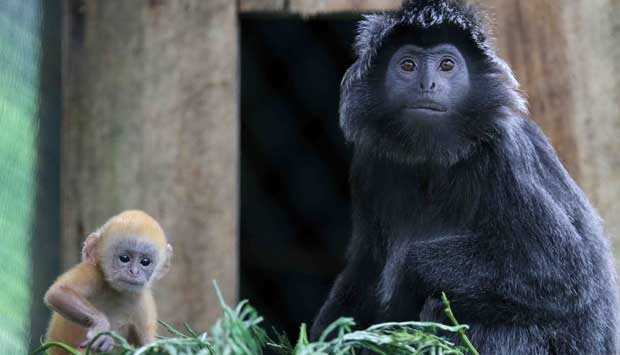Lutung jawa (Trachypithecus auratus)

in this opportunity I will discuss about one of the endemic rare animals of Indonesia namely lutung Jawa or in Latin Trachypithecus auratus,consider the following.
Javan langurs, in Latin called Trachypithecus auratus is one of the native languages (endemic) of Indonesia. Like other species of monkeys, Javan langurs that can also be called buds have a small body size, about 55 cm, with a tail that reaches 80 cm. Javan langurs or monk langur consists of two subspecies namely Trachypithecus auratus auratus and Trachypithecus auratus mauritius. Subspecies Trachypithecus auratus auratus (Spangled Ebony Spine) can be found in East Java, Bali, Lombok, Palau Sempu and Nusa Barung. While the second subspecies, Trachypithecus auratus mauritius (West Java Ebony Langur) found limited in West Java and Banten.
Javan langurs or langurs of budeng in English are known as Javan Lutung, Ebony Leaf Monkey, Javan Langur. While in the scientific language (latin) langur is known as Trachypithecus auratus which has several synonym names such as Trachypithecus kohlbruggei (Sody, 1931), Trachypithecus maurus (Horsfield, 1823), Trachypithecus pyrrhus (Horsfield, 1823), Trachypithecus sondaicus (Robinson & Kloss, 1919), and Trachypithecus stresemanni Pocock, 1934. Physical Characteristics and Behavior. Javan langurs have a body size of about 55 cm with a tail length almost double the length of his body reaches 80 cm. He weighs about 6 kg. Javan langur hair (Trachypithecus auratus) is black and female monkeys have silvery hairs around their genitals. The young Javan langur (lutung budeng) has orange fur. For subspecies Trachypithecus auratus auratus (Spangled Ebony Spine) meliki a race that has a young jaw-like fur with a dark orange fur color with a yellow tip.
Javan langur live in groups. Each group consists of about 7 - 20 heads of a monkey with a male as a group leader and some adult female elders. The female ebony only gives birth to one child during each pregnancy. Some female mothers in one group will help each other in caring for their child, but are often aggressive towards the parent of another group. Javan langur (lutung betung) is a diurnal animal that is more active during the day especially in the tree. Foods of this animal preference include foliage, several kinds of fruits and flowers. Sometimes these animals also eat insects and bark. Habitat and Distribution. Javan langur (Trachypithecus auratus) is an endemic species of Indonesia that can only be found on the island of Java, Bali, Lombok, Palau Sempu and Nusa Barung. The existence of Javan langurs on the island of Lombik allegedly due to the introduction process. The natural habitat of Javan langur (lutung budeng) is a forest area with various variations ranging from coastal mangrove forest, freshwater swamp forest, lowland forest, virgin forest, upland forest up to 3,500 mdp. Javan langurs range reaches 15 ha. Population, Conservation, and Threats. The population of Javan langur (Trachypithecus auratus) decreased further. As such the stars in 2008 are categorized by IUCN Redlist in Conservation status of Threatened (Vulnerable). CITES also incorporates this species in Appendix II. Javan langur populations can still be found in some nature reserves in Java such as Ujung Kulon National Park, Cagara Alam Pangandaran, TN. Meru Betiri, TN. Bromo Tengger Semeru, Mount Halimun, Dieng Mountain, Arjuno Mountain, Alas Purwo etc. The main threat to Javan langur is caused by habitat depletion as the impact of deforestation and human hunting. Finally, surely none of us would be willing to lose this endemic species of Javan langur.